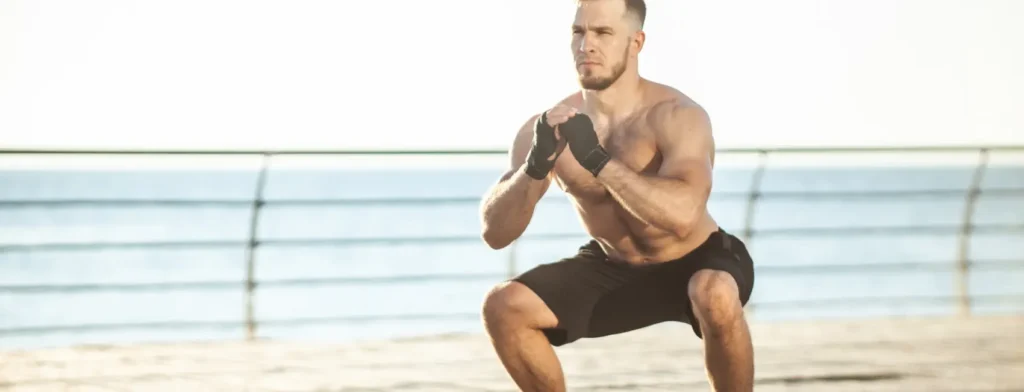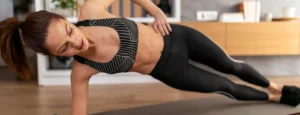A squat is a fundamental lower body exercise that targets multiple muscle groups simultaneously. It involves bending your knees and hips while keeping your back straight and lowering your body toward the ground. Squats primarily work the muscles in your thighs (quadriceps and hamstrings), hips (glutes), and lower legs (calves). This compound movement engages your core for stability and promotes overall lower body strength, power, and flexibility. Squats are versatile and can be performed with various modifications and equipment, making them a popular exercise for building strength, improving athletic performance, and enhancing functional fitness.
Proper squat form is crucial for several reasons. First, it helps prevent injury by ensuring that the muscles and joints are in the correct alignment and under appropriate stress. Second, it maximizes the effectiveness of the exercise, ensuring that the targeted muscles are properly engaged and allowing for optimal strength and muscle development. Lastly, maintaining proper form during squats promotes good posture and body mechanics, which can carry over to other movements and activities, reducing the risk of injury and enhancing overall functional fitness.
Squats – Instructions & Steps
- Stand with your toes out and feet about hip-width apart
- Maintaing your posture, lower yourself keeping you back straight as low as you can go
- Hold for a second, then stand back up straight
Benefits of Squats
Squats offer a wide range of benefits as an exercise and are often considered an essential bodyweight exercise
Lower Body Strength
Squats are a compound exercise that targets the muscles in your thighs (quadriceps and hamstrings), hips (glutes), and lower legs (calves). Regularly performing squats helps build strength and muscular endurance in these muscle groups, leading to stronger and more defined legs.
Increased Muscle Mass
Squats are a highly effective exercise for muscle hypertrophy, which refers to the increase in muscle size. By engaging multiple muscle groups simultaneously, squats stimulate muscle growth and help develop a more muscular physique.
Core Stability
Squats engage the muscles of your core, including the abdominals, obliques, and lower back, to maintain stability throughout the movement. This strengthens your core muscles, improves balance, and supports proper posture.
Improved Athletic Performance
Squats are a functional exercise that translates well to various sports and physical activities. The strength and power developed through squatting can enhance athletic performance by improving speed, jumping ability, and overall lower body explosiveness.
Joint Strength and Stability
Squats promote the strengthening of the joints in the lower body, including the knees, hips, and ankles. This can help improve joint stability, reduce the risk of injuries, and enhance overall joint health.
Bone Density
Weight-bearing exercises like squats stimulate bone growth and help increase bone density. Regular squatting can contribute to stronger bones and reduce the risk of conditions like osteoporosis.
Increased Calorie Burn
Squats are a demanding exercise that requires a significant amount of energy expenditure. Incorporating squats into your workouts can help burn calories, contribute to weight loss or weight maintenance, and improve overall body composition.
Functional Movement
Squats mimic movements we perform in daily life, such as sitting down, standing up, or picking up objects from the ground. By practicing squats, you improve your ability to perform these functional movements with ease and reduce the risk of injury during everyday activities.
Hormonal Response
Squats stimulate the release of hormones like growth hormone and testosterone, which are essential for muscle growth and recovery. This hormonal response can further enhance muscle development and overall body composition.
Versatility
Squats can be performed with various equipment or using just your bodyweight, making them adaptable to different fitness levels and preferences. Additionally, squat variations, such as front squats, overhead squats, or single-leg squats, offer different challenges and target specific muscle groups.
More About Squats
A squat is considered a compound exercise. It is one of the most fundamental and effective compound movements for building strength and muscle mass, primarily targeting the lower body while also engaging several other muscle groups for stabilization.
During a squat, the following muscle groups are engaged:
- Quadriceps: The front thigh muscles work to extend the knee during the upward phase of the squat.
- Hamstrings: The back thigh muscles assist in bending the knees and controlling the descent.
- Glutes: The muscles of the buttocks are heavily activated to push the body back up to the standing position.
- Calves: The calf muscles assist in stabilizing the ankle joint during the squat.
- Core muscles: The abdominal and lower back muscles work to stabilize the spine and maintain proper posture throughout the movement.
- Adductors and Abductors: The inner thigh muscles (adductors) and outer hip muscles (abductors) are activated to stabilize the hips during the squat.
- Erector Spinae: These muscles in the lower back play a crucial role in maintaining an upright posture during the squat.
- Trapezius and Rhomboids: The upper back muscles help to stabilize and support the barbell (if used) during barbell squats.
Due to its engagement of multiple muscle groups and joints, the squat is considered a highly effective compound exercise. It is commonly used in strength training, powerlifting, and general fitness workouts for its ability to build lower body strength, enhance functional movement, and promote overall fitness. Additionally, variations of the squat, such as the front squat and overhead squat, can further emphasize different muscle groups while still being compound movements.



